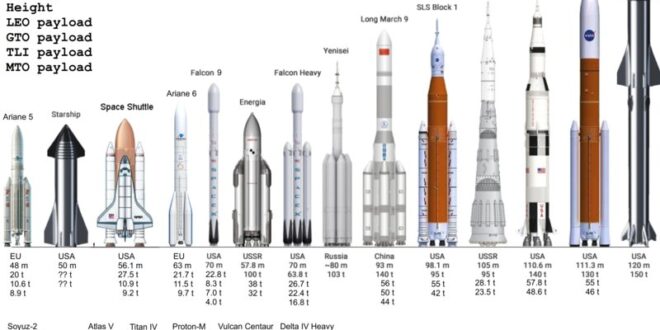Space exploration has always been a testament to humanity’s curiosity and ingenuity. Over the decades, we’ve witnessed remarkable advancements in spacefaring technology, from the iconic Saturn V rocket that propelled humans to the Moon to the ambitious endeavors of SpaceX with its Starship spacecraft. In this article, we’ll delve into the comparisons between these two monumental achievements in space exploration – the Saturn V and the SpaceX Starship.
The Legacy of Saturn V:
The Saturn V rocket stands as a symbol of NASA’s Apollo program, which achieved the historic feat of landing humans on the Moon. Developed in the 1960s, the Saturn V remains the tallest, heaviest, and most powerful rocket ever built. Standing at over 363 feet tall, it was powered by five F-1 engines in its first stage, capable of generating over 7.5 million pounds of thrust. This immense power enabled it to carry payloads of up to 130 tons into low Earth orbit (LEO).
The Saturn V played a pivotal role in shaping our understanding of space exploration and inspiring generations of scientists, engineers, and dreamers. Its missions, including the iconic Apollo 11 that landed the first humans on the Moon in 1969, marked a significant milestone in human history and demonstrated the potential of space exploration.
Enter SpaceX Starship:
Fast forward to the 21st century, and SpaceX, founded by Elon Musk, is revolutionizing space travel with its ambitious Starship project. Designed to be a fully reusable spacecraft, Starship aims to carry both crew and cargo to destinations beyond Earth, including the Moon, Mars, and beyond. With its sleek stainless-steel design and towering presence, the Starship represents a leap forward in spacefaring technology.
One of the key features of the Starship is its Raptor engines, which use liquid methane and liquid oxygen propellants, offering improved efficiency and versatility compared to traditional rocket engines. Additionally, the Starship’s fully reusable design is intended to drastically reduce the cost of space travel, making it more accessible and sustainable in the long run.
Comparing Performance:
When it comes to performance, the SpaceX Starship outshines the Saturn V in several aspects. While the Saturn V could carry heavier payloads to LEO, the Starship boasts a higher payload capacity to orbit with the Super Heavy booster, expected to exceed 100 tons. Moreover, the Starship’s versatility extends beyond LEO, with its capability to perform missions to the Moon, Mars, and potentially even beyond the solar system.
Furthermore, the reusability factor of the Starship is a game-changer in terms of cost-effectiveness. Unlike the Saturn V, which was used only once per mission, the Starship is designed to be rapidly reusable, significantly reducing the cost per launch and opening up new possibilities for frequent space travel and exploration.
Challenges and Opportunities:
However, it’s important to acknowledge the challenges and uncertainties that come with developing and deploying groundbreaking technology like the Starship. SpaceX has faced setbacks and encountered hurdles along the way, from prototype testing failures to regulatory obstacles. Yet, each setback serves as a learning opportunity, driving innovation and refinement of the Starship design.
Looking Ahead:
As SpaceX continues to refine and test its Starship spacecraft, the future of space exploration appears more promising than ever. With the potential to carry humans to Mars and beyond, the Starship embodies humanity’s enduring quest for discovery and exploration. While the Saturn V will forever hold a special place in the annals of space history, the SpaceX Starship represents the next chapter in our journey beyond Earth’s bounds.
Conclusion:
In the grand narrative of space exploration, the Saturn V and the SpaceX Starship stand as milestones of human achievement, bridging the past, present, and future of spacefaring endeavors. While the Saturn V paved the way for humanity’s first steps on the Moon, the Starship promises to take us to new horizons, inspiring future generations to reach for the stars. As we look ahead, the legacy of these iconic spacecraft reminds us of the boundless potential of human ingenuity and the limitless possibilities that await us in the cosmos.
 HammBurg Be informed with latest news, reviews, entertainment, lifestyle tips, and much more.
HammBurg Be informed with latest news, reviews, entertainment, lifestyle tips, and much more.




